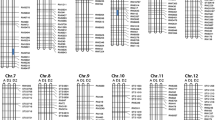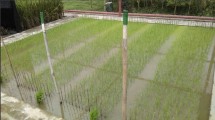Abstract
A new bacterial blight recessive resistance gene xa34(t) was identified from the descendant of somatic hybridization between an aus rice cultivar (cv.) BG1222 and susceptible cv. IR24 against Chinese race V (isolate 5226). The isolate was used to test the resistance or susceptibility of F1 progenies and reciprocal crosses of the parents. The results showed that F1 progenies appeared susceptibility there were 128R (resistant):378S (susceptible) and 119R:375S plants in F2 populations derived from two crosses of BG1222/IR24 and IR24/BG1222, respectively, which both calculates into a 1R:3S ratio. 320 pairs of stochastically selected SSR primers were used for genes’ initial mapping. The screened results showed that two SSR markers, RM493 and RM446, found on rice chromosome 1 linked to xa34(t). Linkage analysis showed that these two markers were on both sides of xa34(t) with the genetic distances 4.29 and 3.05 cM, respectively. The other 50 SSR markers in this region were used for genes’ fine mapping. The further results indicated that xa34(t) was mapped to a 1.42 cM genetic region between RM10927 and RM10591. In order to further narrow down the genomic region of xa34(t), 43 of insertion/deletion (Indel) markers (BGID1-43) were designed according to the sequences comparison between japonica and indica rice. Parents’ polymorphic detection and linkage assay showed that the Indel marker BGID25 came closer to the target gene with a 0.4 cM genetic distance. A contig map corresponding to the locus was constructed based on the reference sequences aligned by the xa34(t) linked markers. Consequently, the locus of xa34(t) was defined to a 204 kb interval flanked by markers RM10929 and BGID25.





Similar content being viewed by others
References
Baker B, Zambryski P, Staskawicz B, Dinesh-Kumar SP (1997) Recognition and signaling in plant-microbe interactions. Science 276:726–733
Chen S, Xu C, Lin X, Zhang Q (2001) Improving bacterial blight resistance of ‘6078’, an elite restorer line of hybrid rice, by molecular marker-assisted selection. Plant Breed 120:133–137
Chen S, Huang ZH, Zeng LX, Yang JY, Liu QG, Zhu XY (2008) High resolution mapping and gene prediction of Xanthomonas oryzae pv. oryzae resistance gene Xa7. Mol Breed 22:433–441
Chu Z, Yuan M, Yao J, Ge X, Yuan B, Xu C, Li X, Fu B, Li Z, Bennetzen JL, Zhang Q, Wang S (2006) Promoter mutations of an essential gene for pollen development result in disease resistance in rice. Genes Dev 20:1250–1255
Huang N, Angeles ER, Domingo J, Magpantay G, Singh S, Zhang G, Kumaravedivel N, Bennett J, Khush GS (1997) Pyramiding of bacterial blight resistance genes in rice: Maker-assisted selection using RFLP and PCR. Theor Appl Genet 95:313–320
Iyer AS, McCouch SR (2004) The rice bacterial blight resistance gene xa5 encodes a novel form of disease resistance. MPMI 17:1348–1354
Iyer-Pascuzzi AS, McCouch SR (2007) Recessive resistance genes and the Oryza sativa–Xanthomonas oryzae pv. oryzae pathosystem. MPMI 20:731–739
Khush GS, Angeles ER (1999) A new gene for resistance to race 6 of bacterial blight in rice, Oryza sativa. Rice Genet Newsl 16:92–93
Khush GS, Taura S, Ogawa T, Yoshimura A, Ikeda R, Omura T (1991) Identification of a recessive resistance gene in induced mutant line XM5 of rice to rice bacterial blight. Jpn J Breed 43:427–432
Kottapalli KR, Kottapalli P, Agrawal GK, Kikuchi S, Rakwal R (2007) Recessive bacterial leaf blight resistance in rice: Complexity, challenges and strategy. Biochem Biophys Res Commun 355:295–301
Leach JE, Vera Cruz CM, Bai J, Leung H (2001) Pathogen fitness penalty as a predictor of durability of disease resistance genes. Annu Rev Phytopathol 39:187–224
Lee KS, Rasabandith S, Angeles ER, Khush GS (2003) Inheritance of resistance to bacterial blight in 21 cultivars of rice. Phytopathology 93:147–152
Nakai H, Nakamura S, Kuwahara S, Saito M (1988) Genetic studies of an induced rice mutant resistant to multiple races of bacterial leaf blight. Rice Genet Newsl 5:101
Natarajkumar P, Sujatha K, Laha GS, Srinivasa Rao K, Viraktamath BC, Mishra B, Reddy CS, Hari Y, Balachandran SM, Ram T, Sundaram RM (2009) Identification, molecular mapping of a novel, dominant bacterial blight resistance gene from O. nivara and marker-assisted introgression of the gene into Samba Mahsuri. In: The 6th international rice genetics symposium, Manila, Philippines, 16–19 November, pp 103
Ogawa T (1996) Monitoring race distribution and identification of genes for resistance to bacterial leaf blight. In: Rice genetics III, proceedings of the third international rice genetics symposium, pp 456–459
Ogawa T, Lin L, Tabien RE, Khush GS (1987) A new recessive gene for resistance to bacterial blight of rice. Rice Genetic Newsl 4:98–100
Petpisit V, Khush GS, Kauffman HE (1977) Inheritance of resistance to bacterial blight in rice. Crop Sci 17:551–554
Ruan HH, Yan CQ, An DR, Liu RH, Chen JP (2008) Identifying and mapping new gene xa32(t) for resistance to bacterial blight (Xanthomonas oryzae pv. oryzae, Xoo) from Oryzae meyeriana L. Acta Agricult Boreali-occidentalis Sin 17:170–174
Shanti ML, George MLC, Vera Cruz CM, Bernardo MA, Nelson RJ, Heung H (2001) Identification of resistance genes effective against rice bacterial blight pathogen in Eastern India. Plant Dis 85:506–512
Sidhu GS, Khush GS, Mew TW (1978) Genetic analysis of bacterial blight resistance in seventy-four cultivars of rice, Oryzae sativa L. Theor Appl Genet 53:105–111
Singh K, Vikal Y, Singh S, Leung H, Dhaliwal HS, Khush GS (2002) Mapping of bacterial blight resistance gene xa8 using microsatellite markers. Rice Genet Newsl 19:94–96
Tagami Y, Mizukami T (1962) Historical review of the researches on bacterial leaf blight of rice caused by Xanthomonas. Spec Rep Plant Dis Insect Pest Forecasting Serv Minist Agric Jpn 10:1–112
Tan GX, Ren X, Weng QM, Shi ZY, Zhu LL, He GC (2004) Mapping of a new resistance gene to bacterial blight in rice line introgressed from Oryzae officinalis. Acta Genet linica 31:724–729 (In Chinese)
Taura S, Ogawa T, Yoshimura A, Ikeda R, Iwata N (1992) Identification of a recessive resistance gene to rice bacterial blight of mutant line XM6, Oryzae sativa L. Jpn J Breed 42:7–13
Wang CT, Wen GS, Lin XH, Liu XQ, Zhang DP (2009) Identification and fine mapping of the new bacterial blight resistance gene, Xa31(t), in rice. Eur J Plant Pathol 123:235–240
Xiang Y, Cao YL, Xu CQ, Li XH, Wang SP (2006) Xa3, conferring resistance for rice bacterial blight and encoding a receptor kinase-like protein, is the same as Xa26. Theor Appl Genet 113:1347–1355
Zeng LX, Huang SH, Wu SZ, Cheng TH (2002) Genetic resistance of rice against Xanthomonas oryzae pv. oryzae high virulence race V. Guangdong Agric Sci 1:35–37 (In Chinese)
Zeng LX, Zhu XY, Yang JY, Wu SY, Chen Z, Chen S (2005) A new pathotype of Xanthomonas oryzae pv. oryzae was found and tested for pathogenicity in Guangdong. Guangdong Agricult Sci 2:58–59 (In Chinese)
Zhai WX, Wang WM, Zhou YL, Li XB, Zheng XW, Zhang Q, Wang GL, Zhu LH (2002) Breeding bacterial blight resistant hybrid rice with the cloned bacterial resistance gene Xa21. Mol Breed 8:285–293
Zhang QF, Shen BZ, Dai XK, Mei MH, Maroof MAS, Li ZB (1994) Using bulked extremes and recessive class to map genes for photoperiod-sensitive genic male sterility in rice. Proc Natl Acad Sci USA 91:8675–8679
Zhang Q, Wang CL, Zhao KJ, Yang WC, Qiao F, Zhou YL, Jiang QX, Liu GC (2002) Development of near-isogenic line CBB23 with a new resistance gene to bacterial blight in rice and its application. Chin J Rice Sci 16:206–210
Acknowledgments
We thank Dr. John Pinar in South China Normal University for his critical revision of the manuscript. This research was supported by the Earmarked Fund for Modern Agro-Industry Technology Research System, the Commonweal Vocation (Agriculture) Scientific Research Special Foundation (nyhyzx07-056) and the Fundamental Science Foundation of Guangdong Academy of Agricultural Sciences (07-JC-05).
Author information
Authors and Affiliations
Corresponding author
Additional information
Communicated by T. Sasaki.
S. Chen and X. Liu contributed equally to this work.
Rights and permissions
About this article
Cite this article
Chen, S., Liu, X., Zeng, L. et al. Genetic analysis and molecular mapping of a novel recessive gene xa34(t) for resistance against Xanthomonas oryzae pv. oryzae . Theor Appl Genet 122, 1331–1338 (2011). https://doi.org/10.1007/s00122-011-1534-7
Received:
Accepted:
Published:
Issue Date:
DOI: https://doi.org/10.1007/s00122-011-1534-7




